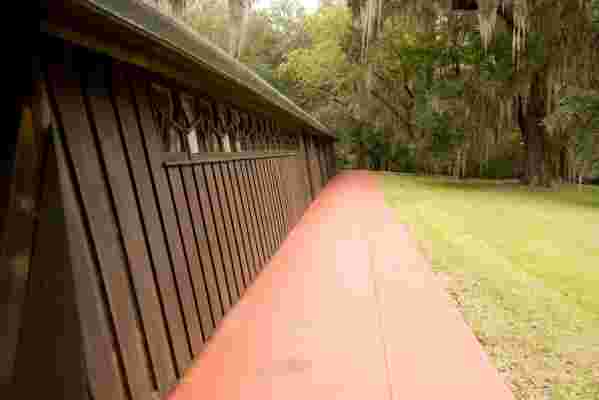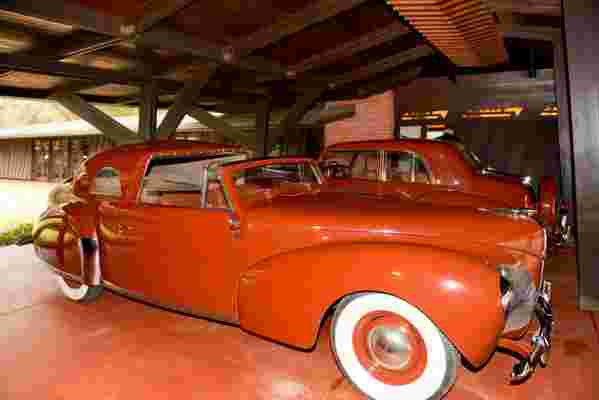Frank Lloyd Wright designed Auldbrass, a farm and retreat along South Carolina's coastal Lowcountry, for C. Leigh Stevens—a Michigan industrialist. Wright began working on the project in the late 1930s and continued for nearly 20 years, until just before his death in 1959. In visiting the site, which we had the opportunity to do as part of a private tour last weekend, it is easy to see why.
The original plan for the complex included dozens of buildings: barns, chicken coops, caretakers cottages, guest cabins, dog kennels, an aviary, a main house, men’s and women’s bathing houses, a two-story guest house with a high diving platform, a 16-foot-deep pool, and even a 32-foot fiberglass dinner barge to float on the property’s bucolic lake.

Each board on the building is tilted at a nine-degree angle, a design decision that was inspired by the lean of the stately live oak trees throughout the landscape.
Many of these structures were actually built on the 320-acre Combahee riverfront site during Wright’s lifetime. And all were constructed with Wright’s typical imperious vision and attention to detail, including custom features such as hand-carved clerestory windows, modular tessellated hexagonal tabletops, abstracted and intricate copper downspouts inspired by the local Spanish moss, and vertical wooden siding on every one of the low-rise buildings in which each board is both tilted from vertical and sloped in from upright at a nine-degree angle, said to be inspired by the average lean of the stately live oak trees that dominate the landscape.
As with many Wright properties, the buildings were prohibitively expensive to build and more so to maintain, and the site fell into grave disrepair in the latter part of the 20th century, more so after a fire decimated a portion of the barn and main house. Fortunately for architecture fans, movie producer Joel Silver (of the Lethal Weapon, Die Hard, and The Matrix franchises) purchased the estate in the late 1980s, and has been painstakingly restoring the property to its former and intended glory. Even more fortunate, his team of architects and contractors were able to access hundreds of original drawings and plans, and to work with Wright’s grandson Eric Lloyd Wright on the renovation of the buildings and furnishings, as well as the construction of unbuilt structures and appointments that Wright had designed for the site.

Visitors can see a pair of prewar Lincoln Continentals that were once owned by Frank Lloyd Wright and were among his favorite cars.
In the process, Silver—an avid car collector—also purchased a pair of prewar Lincoln Continentals that the Ford Motor Company had gifted Wright as part of a prescient “influencer” advertising campaign, in which vehicles were given to 20 prominent Americans. Wright insisted on receiving two cars (a coupe and a convertible) as well as having them painted his signature brick-like Cherokee Red. The convertible was severely damaged in a rollover accident early in Wright’s ownership, and it was subsequently customized by Wright into a Brougham—a car with an open driver’s compartment and a closed passenger compartment. These cars, stunning examples of Streamline Moderne American styling, are rarely shown to the public but were also made available during our visit.
The house and grounds are open to the public very infrequently, but the site will host guided tours this coming weekend , November 9–11. Tickets are still available, and the price supports the Beaufort County Open Land Trust.
